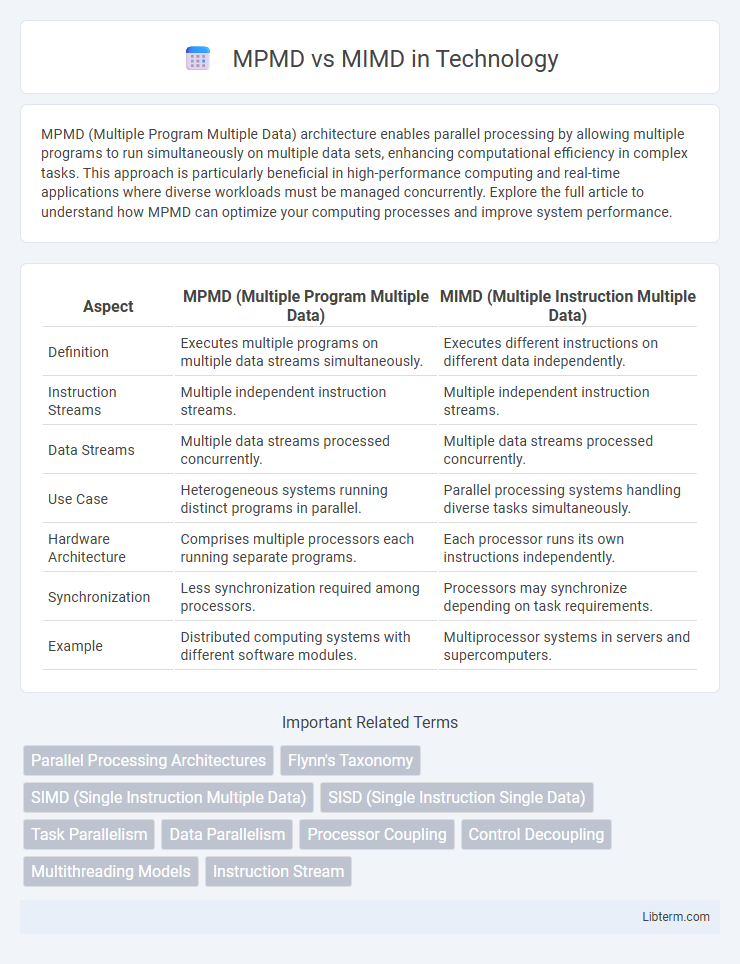MPMD (Multiple Program Multiple Data) architecture enables parallel processing by allowing multiple programs to run simultaneously on multiple data sets, enhancing computational efficiency in complex tasks. This approach is particularly beneficial in high-performance computing and real-time applications where diverse workloads must be managed concurrently. Explore the full article to understand how MPMD can optimize your computing processes and improve system performance.
Table of Comparison
| Aspect | MPMD (Multiple Program Multiple Data) | MIMD (Multiple Instruction Multiple Data) |
|---|---|---|
| Definition | Executes multiple programs on multiple data streams simultaneously. | Executes different instructions on different data independently. |
| Instruction Streams | Multiple independent instruction streams. | Multiple independent instruction streams. |
| Data Streams | Multiple data streams processed concurrently. | Multiple data streams processed concurrently. |
| Use Case | Heterogeneous systems running distinct programs in parallel. | Parallel processing systems handling diverse tasks simultaneously. |
| Hardware Architecture | Comprises multiple processors each running separate programs. | Each processor runs its own instructions independently. |
| Synchronization | Less synchronization required among processors. | Processors may synchronize depending on task requirements. |
| Example | Distributed computing systems with different software modules. | Multiprocessor systems in servers and supercomputers. |
Introduction to Parallel Processing Architectures
MPMD (Multiple Program Multiple Data) and MIMD (Multiple Instruction Multiple Data) are crucial architectures in parallel processing that enable simultaneous execution of different instructions on different data sets. MIMD systems allow processors to execute independent programs concurrently, enhancing flexibility in multitasking and complex computations. MPMD, a subset of MIMD, specifically involves multiple processors running distinct programs on separate data streams, optimizing computational efficiency in heterogeneous tasks.
Defining MPMD (Multiple Program Multiple Data)
MPMD (Multiple Program Multiple Data) is a parallel computing model where multiple autonomous processors execute different programs on different data sets simultaneously. This model contrasts with MIMD (Multiple Instruction Multiple Data) by emphasizing the execution of entirely distinct applications or programs rather than different instructions within a single program. MPMD is widely used in large-scale distributed systems and complex simulations requiring diverse computational tasks to run concurrently.
Understanding MIMD (Multiple Instruction Multiple Data)
MIMD (Multiple Instruction Multiple Data) architecture allows multiple processors to execute different instructions on different data sets simultaneously, enhancing parallelism and computational efficiency. It supports a variety of parallel processing models, including shared memory and distributed memory systems, making it highly versatile for complex applications like scientific simulations and real-time data analysis. Understanding MIMD is crucial for optimizing multiprocessing environments where tasks require diverse operations on distinct data sets concurrently.
Key Differences Between MPMD and MIMD
MPMD (Multiple Program Multiple Data) executes different programs on multiple processors, each handling unique data sets, optimizing task parallelism in heterogeneous computing environments. MIMD (Multiple Instruction Multiple Data) allows processors to independently execute different instructions on different data, offering high flexibility for parallel processing in complex applications. The key difference lies in MPMD running distinct programs simultaneously, while MIMD emphasizes independent instruction streams on various data for parallel execution.
System Architecture: MPMD vs MIMD
MPMD (Multiple Program Multiple Data) and MIMD (Multiple Instruction Multiple Data) are parallel computing architectures that differ in program execution models. MPMD executes multiple programs on multiple data sets simultaneously, allowing diverse software components to run concurrently within a distributed system. MIMD, by contrast, involves multiple processors independently executing different instructions on different data, making it versatile for complex, asynchronous, and heterogeneous computing tasks in shared-memory or distributed-memory architectures.
Programming Models for MPMD and MIMD
MPMD (Multiple Program Multiple Data) programming models involve executing different programs on multiple processors, each handling distinct datasets, facilitating coarse-grained parallelism. MIMD (Multiple Instruction Multiple Data) programming models support asynchronous parallelism where processors execute different instructions on different data, often employing shared or distributed memory architectures with dynamic task scheduling. Both models require specialized synchronization and communication mechanisms, with MPMD favoring independent program execution and MIMD enabling fine-grained parallelism through concurrent instruction streams.
Performance Comparison: MPMD vs MIMD
MPMD (Multiple Program Multiple Data) and MIMD (Multiple Instruction Multiple Data) architectures differ significantly in performance characteristics, with MIMD offering greater flexibility and higher throughput by enabling independent instruction streams on separate processors. MPMD systems often face synchronization overheads that can limit scalability, whereas MIMD achieves better parallelism in complex, heterogeneous tasks due to its asynchronous execution model. Benchmarks demonstrate MIMD's superior efficiency in handling irregular workloads and dynamic task allocation compared to MPMD's more rigid program coordination.
Scalability and Flexibility Considerations
MPMD (Multiple Program Multiple Data) architectures offer enhanced scalability by allowing diverse programs to execute concurrently across multiple processors, facilitating efficient parallel processing for complex applications. In contrast, MIMD (Multiple Instruction Multiple Data) provides greater flexibility by enabling each processor to run different instructions independently on various data sets, accommodating a wide range of computing tasks. Scalability in MPMD systems is often leveraged in distributed computing environments, while MIMD's flexibility supports dynamic workloads in shared-memory multiprocessors and heterogeneous computing platforms.
Real-world Applications of MPMD and MIMD
MPMD (Multiple Program Multiple Data) architectures excel in heterogeneous computing environments such as scientific simulations and large-scale weather modeling, where different processors execute distinct program codes on separate data sets. MIMD (Multiple Instruction Multiple Data) systems are widely utilized in parallel computing tasks like complex database operations, real-time processing, and artificial intelligence applications, offering simultaneous execution of different instructions on various data. Both MPMD and MIMD architectures enable efficient processing in high-performance computing clusters and distributed systems, optimizing resource utilization for diverse computational workloads.
Future Trends in Parallel Computing Architectures
MPMD (Multiple Program Multiple Data) and MIMD (Multiple Instruction Multiple Data) architectures are pivotal in advancing parallel computing by enabling simultaneous execution of diverse instruction streams across multiple processors. Future trends emphasize heterogeneous computing models integrating MPMD and MIMD to optimize performance in AI, big data analytics, and edge computing environments. Emerging technologies like quantum accelerators and neuromorphic chips will further enhance MPMD/MIMD systems, driving scalability and energy efficiency in next-generation parallel architectures.
MPMD Infographic

 libterm.com
libterm.com